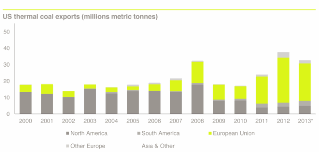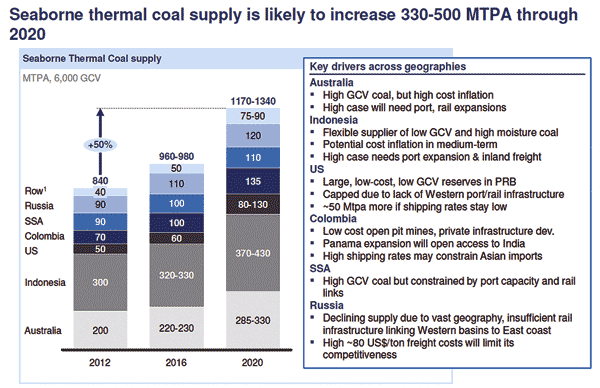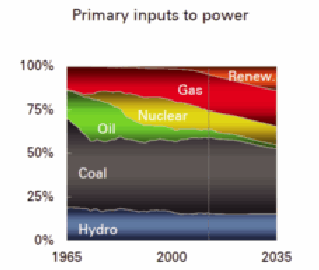Positive comments were few and far between at this year’s Coaltrans USA conference held in Miami February 6-7. While presenters offered some optimism on the U.S. thermal coal side — with a harsh winter leading to an increase in coal production — discussions regarding seaborne met coal dealt with its numerous challenges including oversupply, the strength of the U.S. dollar versus the Australian dollar, environmental and taxation regulations, and future growth areas.
In the keynote address, Paul Reagan, president of Sampling Associates International, echoed these somber sentiments and took a cue from his teenage daughter when describing the current situation. “We are here today to ponder the great questions of our industry,” Reagan said. “How much does it suck? Why will it suck? And how long will it suck?”
His remarks were met with laughter, but all in attendance knew the seriousness of the questions.
Some of the main concerns for the coal industry are environmental regulations and taxation, the weak Australian dollar, and the future of China, Reagan said.

Figure 2: U.S. coal exports continue to grow with Europe, the prime recipient, due to proximity. (Source: Ernst and Young)
However, he said, “Where there are challenges, there are always opportunities.”
Thermal Coal Tightens
The rise of shale gas, environmental policies and plant economics have limited the prospects for coal’s longer term growth domestically, according to Bob Stall, principal for Ernst and Young.
Retirements of coal-fired plants are far outpacing new additions. However, new state-of-the-art plants, clean coal technologies and exports offer a viable option for coal suppliers, he said.
According to Nathan Flesher, director of operations for McKinsey and Co., the outlook for U.S. thermal coal is moderate. Domestically, it is demand constrained until 2030, he added.
However, due to the polar vortex, or as Kevin Crutchfield, chairman and CEO of Alpha Natural Resources, jokingly called “winter,” natural gas prices rose and thermal coal had to step in and fulfill the demand for electricity.
“All this is a simple reminder to regulators that having all your eggs in one basket is just a recipe for scrambled eggs,” Crutchfield said.
With natural gas price volatility, including short-term spikes, many plants have switched back to coal-fired generation, said Stall. In 2013, coal regained some of the market share that was lost to natural gas in 2012 when prices fell to historic lows. The harsh winter has led to coal increasing even more of that share.
This solidified what many in the coal industry have stated, that natural gas has volatile pricing and removing coal from America’s energy portfolio is a mistake.
“Coal stands firmly as a central part of the energy picture,” Crutchfield said. Even though the Obama administration’s “message for coal is clear. They want the industry gone,” he said.
Crutchfield spoke briefly on the proposed carbon capture rule for new coal-fired plants, as well as the soon-to-be rule for existing plants. He reiterated what many have said before, that carbon capture technology is still in its infancy and all want to be a part of a better, cleaner energy picture.
According to Crutchfield, if all existing coal-fired plants were closed, it would reduce greenhouse emissions by 3%. He stressed the importance of campaigning at the state level and showing Americans the whole picture. “Decisions need to be made based on fact,” he said.
He gave examples of countries who decided to turn away from coal and rely on renewable energy, offering huge subsidies programs, including the U.K and Germany, and who have now returned to coal. Across Europe, 69 coal-fired plants are under development, with 10 in Germany alone, Crutchfield said.
In 2012, coal was the dominant fuel for electricity generation in the U.K., which hasn’t been the case since 2007, he added.
This is very different from the U.S., according to Stall. In Europe, natural gas consumption has been declining since 2011 and coal consumption has been increasing.
Crutchfield also touched on the demand for thermal coal in developing countries, which he felt the U.S. coal industry has a moral obligation to provide, to help them receive basic utilities, ones people in the U.S. take for granted, he said. “It’s raising their standard of living, just like it raised ours,” he said.
J. Brett Harvey, CEO of CONSOL Energy, also felt it was a moral issue and cited the 1.3 billion people around the world who still lack access to electricity. “The developing world is in the midst of an industrial revolution,” he said. He described their thirst for energy and compared it to the U.S. Industrial Revolution.
Emerging markets, led by China, will drive growth of just more than 3% in electricity generation through 2040 in non-OECD member countries, according to Stall. “That southeast Asia block is going to be where the biggest new sect of power generation, coal power generation, is going to be,” he said.
In global electricity generation, coal will drop from 2010’s 40% share to 36% in 2040, according to Stall. “Where that coal is fired is going to be very different from where it currently is today,” Stall said. Adding that a big push forward will be seen from non-OECD countries, and those OECD countries will pull back.

Figure 3: Seaborne thermal coal supply is likely to increase 300-500 MPTA through 2020. (Source: McKinsey & Co.)
The seaborne market for coal has got to grow to meet this demand, Stall said.
This falls in line with what both Harvey and Crutchfield expressed, he said. “Give those countries the opportunity to have the economic prosperity that the U.S. enjoyed as we built our economy using fossil fuels,” Stall added.
Natural Gas also Has its Challenges
The not-so-good news for the U.S. coal industry is that shale growth is largely in the east, but is starting to move to the west, according to John Corrigan, partner of consulting firm, Booz and Co. A lot of backlogged gas is coming into the market and shale gas is everywhere, he said.
Costs associated with drilling the wells, which ranges from about $6 million to $12 million, are decreasing, Corrigan said, which is not good for coal. “They are able to do it much more cost effective than they have in the past,” he added.
According to the U.S. Energy Information Administration (EIA), shale is a big wedge that’s replacing the other fuels, Corrigan said. “It’s growing at a rapid rate,” he added.
Power generation is where gas is competing directly with coal. A lot of the new plants being built are gas plants because of the fear of potential Environmental Protection Agency rules, he said. “Gas is now seen as the sort of no regrets kind of move for a lot of utilities,” he said.
Natural gas is competing at the baseload level, which hadn’t been seen before, Corrigan said.
However, the big problem for gas is the lack of infrastructure. The pipelines are not there, he said.
Stall agreed and said one of the issues is not having the land available to put in the pipeline. He also felt there was a lot of risk out there in dealing with gas.
There is also more preference for coal plants to run seasonally because it is more reliable and easier to keep inventory. “Coal should have a leg up in firm dispatchable power,” Corrigan said.
Other issues are different delivery and operating cycles for gas and power generation.
There is also an issue with planning coordination, he said. Coal should have a leg up in that regard for the next three to five years, he added.
“The world according to gas will look very different in the next three to five years,” Corrigan said. Due to the lack of infrastructure, gas may have to seek other alternatives, he added.
Global Market for Coal Will Increase
According to Flesher, seaborne thermal coal supply is going to increase drastically. They predict an increase in coal from Australia, Indonesia, some from the U.S. and Colombia.
“There will be, over the next eight to 10 years, a substantial increase in seaborne coal,” Flesher said. There is an uncertainty in the seaborne coal trade, he said, so producers need to focus on operational costs by reducing costs and improving productivity.
U.S. coal is capped because of a lack of Western port and rail infrastructure, he said. If new infrastructure investments are made in the western U.S., this could dramatically increase U.S. coal export capacity, he said.
Port infrastructure, a lack of access and transportation costs are constraining the export capacity of major coal producing basins, Stall said. In the Powder River Basin (PRB), they are constrained by transportation costs and they are competing with metallurgical coal. However, Stall felt PRB would probably be where the bulk of exports will come from because of its low cost. He added thar central Appalachia also has limited port access. There are three proposed port expansions: Gateway Pacific Terminal, Millennium Bulk Terminal and Morrow Pacific coal export terminal, which will increase export capacity by 106 million tons,” he said.
One of the other challenges in the global met market, according to Ernie Thrasher, CEO of Xcoal Energy and Resources, is the world economy with the center of growth shifting to the area ranging from the Indian subcontinent to Japan, as well as several countries experiencing currency crises.
“Our customers are struggling and there is a level of fear and anxiety about what the next moves are going to be from a global economy standpoint,” Thrasher said.
The largest competitor for the U.S. in the met coal industry is Australia, he said, and their currency is way down.
“And they are using it against us,” he said.

Figure 4: Coal’s share of electricity generation through 2035. (Source: Ernie Thrasher)
With a majority of the global population concentrated in Asia, Thrasher said one of their many challenges is getting coal to those areas and competing with other countries that are much closer to Asia than the U.S.
There is also an oversupply of coal, he said. Coal companies responded to the demand by building or expanding mine operations.
Another thing affecting the industry is environmental regulations. China has initiated policies to close steel mills and cokeries that are either inefficient or in areas of high levels of pollution. They are also looking at closing many coal-fired plants and restrict the quality of imported coal. Of course, the U.S. is no stranger to environmental regulations regarding coal production.
In several countries, there is some form of a carbon tax being proposed. Thrasher cited South Korea and its proposal of a carbon tax of $17/metric ton of coal. This country depends on coal for 44% of its electricity generation, he said.
Another challenge is product substitution. Steel companies and merchant coke makers are shifting to lower grade coal, which doesn’t typically come from the U.S., he said. New technology is reducing the need for high-quality, U.S. coking coal, he added. Gas is also being used in blast furnaces as a substitute for coal. There is also the possibility of shale deposits spreading to other parts of the world, reducing the growth in demand for coal, he said.
However, regardless of all of this, “there is no denying that coal remains the lowest cost form of energy for any group or society to improve the standard of living,” Thrasher said.
This is just one of the opportunities for coal, he said. Thrasher also cited plentiful supply, which can be both good and bad, existing infrastructure, and demand growth.
Through 2035, the demand for coal is forecast to increase by more than 1 billion tons, he said. “It’s not all seaborne coal, but I think it once again reaffirms that the demand for coal will be there,” he said.
There aren’t any unbiased energy forecasts that reduce the global consumption of coal through 2040, he added.
Although the global market continues to grow, it is challenged by oversupply and market prices. The companies that survive will be those low cost producers, he said.




